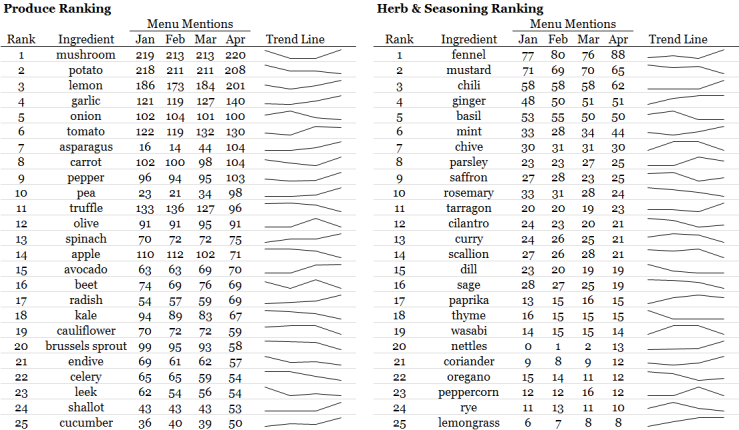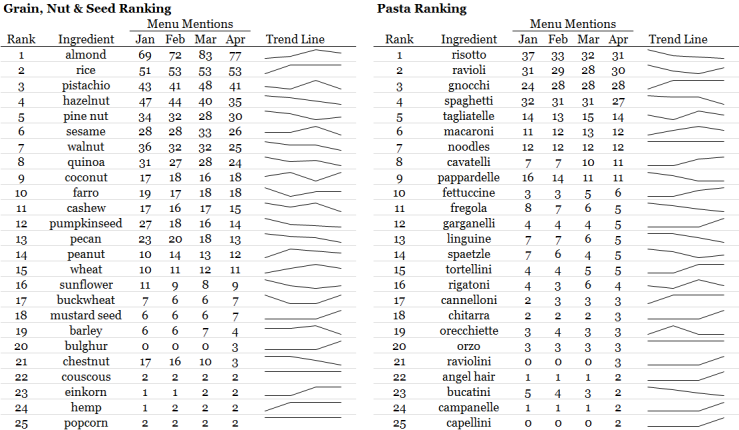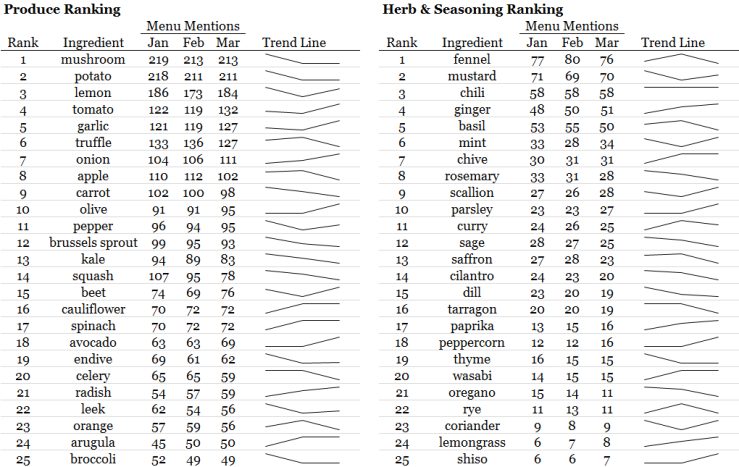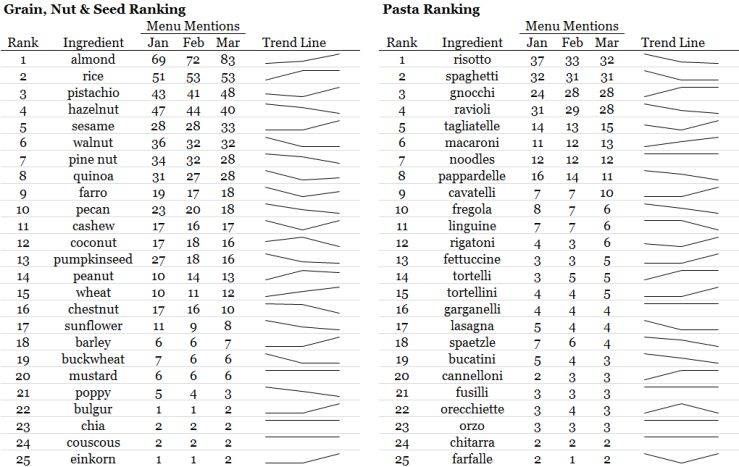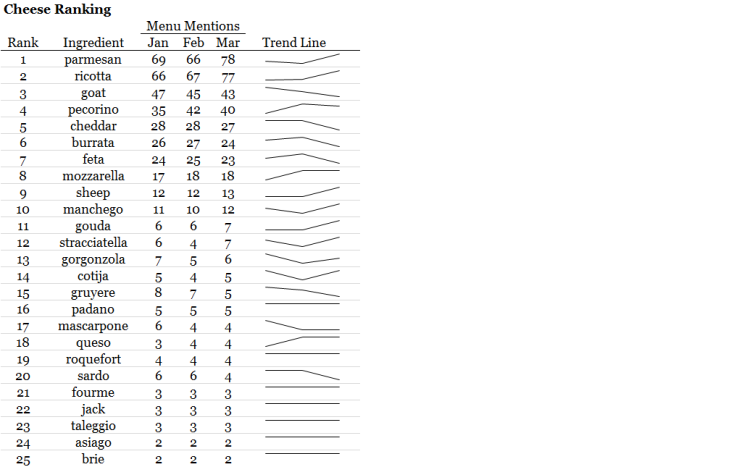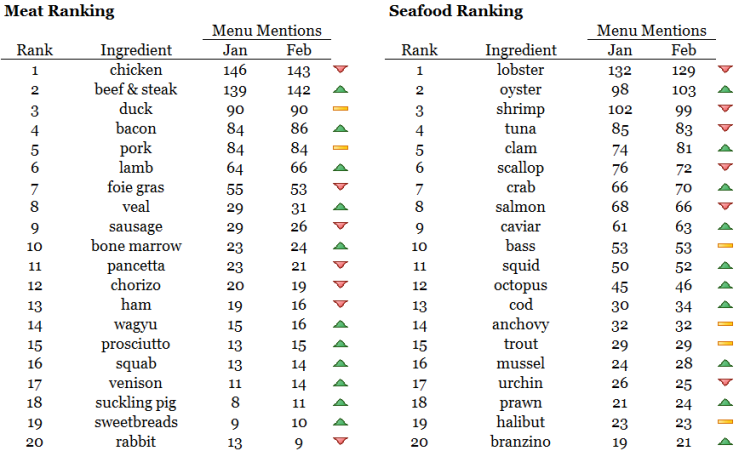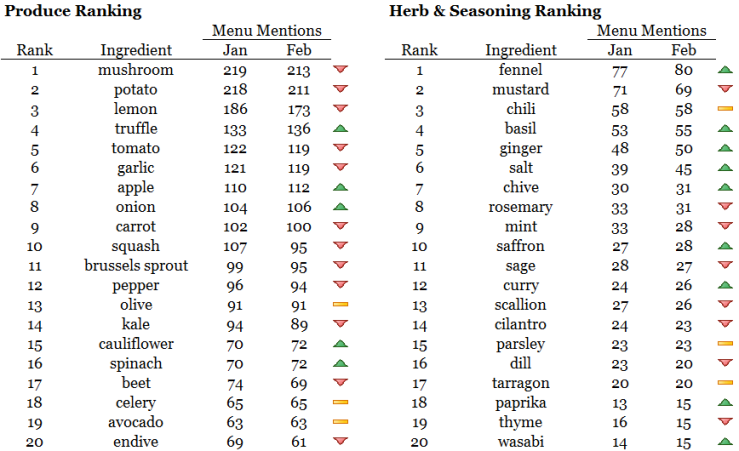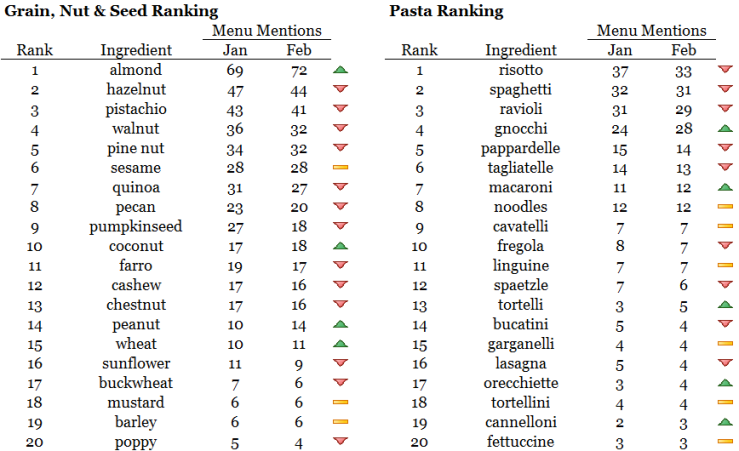Nuts and nut flavorings are integral components of many cocktails. We track the menus at fifty of New York City’s most noteworthy cocktail bars, and these menus contain over eighty cocktails featuring nuts. These cocktails utilize ten distinct varieties, from walnuts and almonds to the lesser-known kola nut.
The Dead Rabbit in NYC is the leader when it comes to using nuts in cocktails. In fact, the bar has nearly ten cocktails utilizing them. In addition to using shaved nuts as a garnish, bartenders use nut-based products including infused spirits, liqueurs, syrups, tinctures, butters and bitters.

Found on the menus that we track, below are the three cocktails that have the largest nut influences, with each featuring multiple types of nuts. At the top of the list is Bonnie Vee’s ‘Marian Alexander’. Every ingredient in the concoction is nut based.
‘Marian Alexander’
Cocktail Bar: Bonnie Vee
Ingredients: Walnut-Infused Armagnac, Walnut Liqueur, Coco Lopez (Cream of Coconut), Almond Milk
‘Jailbird’
Cocktail Bar: The Dead Rabbit
Ingredients: Bourbon Whiskey, Calvados, Madeira, Macadamia, Almond, Pimento Bitters, Cream Float (Served Hot)
Pictured Here
‘Dr. Walnut’
Cocktail Bar: The Nomad Bar
Ingredients: Genever, Amaro Cio Ciaro, Royal Combier, Hazelnut Liqueur, Lemon, Egg White, Shaved Walnuts
Pictured Here
Below, we have listed the ten nut varieties used at the cocktail bars that we track and provided examples of cocktails that are currently being served. Each of the nut varieties bears a unique flavor profile and are commonly found alongside distinct sets of ingredients.
WALNUT
Walnuts are used more commonly on the menus that we track than another other nut, used in twenty-two cocktails. The nut often appears alongside sherry and whiskeys, and is frequently paired with banana, maple syrup and coffee flavors.
Walnut flavor is added into the cocktails in various ways, often introduced through either walnut bitters, the Italian walnut liqueurs Nocino and Nocello, or the Austrian walnut liqueur Nux Alpina. In some cases, shavings from the nut are simply added to the cocktail as a garnish.
A distinction is often made on menus between black walnuts and ‘regular’ walnuts (known as English walnuts). Black walnuts have a strong, earthy flavor, and are far rarer than their traditional counterpart. The husk of the black walnut is much harder to crack, but when ground, it is commonly used for its health benefits. This hull powder is commercially available, and is used on one of the menus that we track.
Below is a representative sample of cocktails featuring walnut:
‘Breakfast of Champions’
Cocktail Bar: Analogue
Ingredients: Cutty Sark Prohibition Scotch, Fino Sherry, Giffard Banana, Vanilla Syrup, Walnut Bitters
‘Dead Poet’
Cocktail Bar: Apothéke
Ingredients: Bourbon, Rye, Espresso, Black Walnut Husk, Allspice, Smoked Clove, Agave
‘Great Jones’
Cocktail Bar: The Wren
Ingredients: Famous Grouse Scotch, Walnut Liqueur, Maple Syrup, Black Walnut Bitters
‘Dos Gardenias’
Cocktail Bar: The Nomad Bar
Ingredients: Blended Scotch Whiskey, Palo Cortado Sherry, Nocino (a Walnut Liqueur), Gardenia Mix, Maple Syrup, Chocolate Bitters
Recipe
‘Dippermouth’
Cocktail Bar: Karasu
Ingredients: Bourbon, Black Walnut, Crème de Banana, Cold Brew
Pictured Here
COCONUT
Coconut appears in twenty cocktails on the menus that we track. A wide variety of coconut-based ingredients are used by bartenders including:
- Cream of Coconut
- Coconut Water
- Coconut Grenadine
- Kalani Coconut Liqueur
- Coconut Cordial
- Coconut-infused Bourbon
- Coconut Rum
Additionally, coconut oil is also used to fat-wash the rum in Mace’s ‘Curry Leaf’ cocktail. The cocktail bar Mace serves more coconut cocktails than any other bar that we track, with four creations featuring the tropical nut.
Perhaps unsurprisingly, rum is the spirit that is used alongside coconut flavor the most. Vermouth and sherry, both fortified wines, each appear in several coconut cocktails as well. Additionally, lime juice, pineapple juice and Angostura bitters are frequently used.
Below is a representative sample of cocktails featuring coconut:
‘Five Finger Death Punch’
Cocktail Bar: Slowly Shirley
Ingredients: Five Spice Infused Angostura, Rum, Coconut Grenadine, Lime
Pictured Here
‘Rebel Extravaganza’
Cocktail Bar: Grand Army
Ingredients: Rye Whiskey, Pedro Ximénez Sherry, Coconut, Pineapple, Allspice Dram, Angostura Bitters
‘The Escape’
Cocktail Bar: The Rum House
Ingredients: El Dorado Dark Rum, Coconut Crème, Pineapple Juice, Sweet Vermouth
Recipe and Photo
‘Mr. Marcis’
Cocktail Bar: The Bar at Eleven Madison Park
Ingredients: Coconut-Infused Bourbon, Chambèry Blanc Vermouth, Maple, Angostura Bitters
‘Curry Leaf’
Cocktail Bar: Mace
Ingredients: Coconut Oil Fat-washed Barbados Rum, Cynar 70, Sweet Vermouth, Curry Leaf Bitters
Pictured Here
ALMOND
Tied with coconut, almond flavor also appears in twenty cocktails on the menus that we track. In addition to pure almond shavings, other almond products used in cocktails include almond milk and Amaretto, an almond flavored Italian liqueur. On top of these twenty almond cocktails, many others include Orgeat, a syrup which is usually (but not always) made from almonds, sugar and flower water.
Almond flavor is most frequently used alongside scotch, rum and absinthe. The flavor also works well with lemon juice and teas, including green tea and masala chai. See this link for a similar article on how fourteen types of tea are used in cocktails.
Below is a representative sample of cocktails featuring almond:
‘Chai Me A River’
Cocktail Bar: Boilermaker
Ingredients: Aviation Gin, Apple Schnapps, Almond Milk, Chai Tea, Angostura Bitters
Pictured Here
‘Hops/Scotch’
Cocktail Bar: Suffolk Arms
Ingredients: Monkey Shoulder Scotch, Lemon, Apricot, Almond, Splash of IPA
Pictured Here
‘Brute Force’
Cocktail Bar: The Dead Rabbit
Ingredients: Tequila Blanco, Jamaican Overproof Rum, Pear, Green Tea, Almond, Lime, Absinthe
Pictured Here
‘Almond’
Cocktail Bar: ZZ’S Clam Bar
Ingredients: Almond Rums, Curaçao, Lime
‘Loose Lips Sink Ships’
Cocktail Bar: Dram
Ingredients: Gin, Cranberry Liqueur, Amaretto, Orgeat, Punt e Mes, Absinthe
PISTACHIO
In 2015, Eater noted a pistachio trend emerging in the cocktail world. Today, pistachio is the fourth most common nut featured on the menus that we track, used in syrups and tinctures.
Instead of using an almond-based orgeat like most cocktail bars, The Up & Up utilizes a pistachio orgeat in several of its cocktails. ZZ’s Clam Bar uses a pistachio tincture alongside gin, honey and cumquat.
Pistachio flavor is usually found in rum cocktails, and other ingredients that are frequently found alongside pistachio include lime and cream.
Below is a representative sample of cocktails featuring pistachio:
‘The Gap Theory’
Cocktail Bar: The Up & Up
Ingredients: Plantation 3-Star Rum, Pear Brandy, Pistachio Orgeat, Honey, Lime Juice, Jalapeño, Cream
‘The Rhum Around’
Cocktail Bar: Manhattan Cricket Club
Ingredients: A Blend of 3 Aged Plantation Rums, Pistachio Tincture, Lime, Agave
‘Bluecoat’
Cocktail Bar: The Dead Rabbit
Ingredients: Japanese Whisky, Amaro, Pistachio, Basil, Kaffir Lime Leaf, Rice Milk, Lime
‘Pistachio’
Cocktail Bar: ZZ’S Clam Bar
Ingredients: Pistachio, Gin, Honey, Cumquat
HAZELNUT
Of the five hazelnut cocktails on the menus that we track, the nut was used alongside brandy in two of them. Apple flavor is also found in two of the cocktails, with Seamstress using Apple Jack, and Clover Club using apple brandy alongside hazelnut-infused bourbon.
Below is a representative sample of cocktails featuring hazelnut:
‘Velveteen Rabbit’
Cocktail Bar: Analogue
Ingredients: Remy Martin 1738 Cognac, Toasted Hazelnut Orgeat, Nux Alpina, Lemon, Egg Whites, Whiskey Barrel Bitters, Crushed Hazelnuts
Pictured Here
‘Out of Darkness’
Cocktail Bar: Seamstress
Ingredients: Wild Turkey 101, Apple Jack, Hazelnut, Benedictine, Bitters
‘Log Cabin’
Cocktail Bar: Clover Club
Ingredients: Apple Brandy, Hazelnut-infused Bourbon, Maple Syrup, Angostura Bitters
PEANUT
On the menus that we track, there are two cocktails which contain peanuts. Both are whiskey drinks and include peanut butter.
‘Charlie Brown’
Cocktail Bar: Angel’s Share
Ingredients: American Whiskey Alibi, Peanut Butter, Aterna Cream, Milk, Topped with Nutmeg
Pictured Here
‘Peanut Butter’
Cocktail Bar: ZZ’S Clam Bar
Ingredients: Peanut Butter Bourbon, Pineapple, Banana
MACADAMIA
Two cocktails on the menus that we track include macadamia nuts. The ‘Jailbird’ cocktail, which is featured at the outset of this article, is topped with grated macadamia. The Dead Rabbit features another macadamia cocktail called ‘Kissin’ Cousin’. The full ingredient list is below:
‘Kissin’ Cousin’
Cocktail Bar: The Dead Rabbit
Ingredients: Fino Sherry, Pineapple Rum, Gentiane, Macadamia, Mace, Lemon
Pictured Here
CASHEW
Cashew flavor is featured in one cocktail on the menus that we track in the form of an infused rum. Below is the concoction which was created by Freemans:
‘La Boca Chica’
Cocktail Bar: The Bar at Freemans
Ingredients: Cashew Rum, Velvet Falernum, Nutmeg
CHESTNUT
Chestnut, an NYC favorite during the winter months, is found in one cocktail on the menus that we track. The ingredient list is below:
‘Paper Crane’
Cocktail Bar: Apothéke
Ingredients: Amazake with Persimmon, Bourbon, Cinnamon, Fresh Chestnut (Served Hot)
Pictured Here
KOLA NUT
The kola nut, pictured here, is sourced from African rainforests and contains caffeine. The nut has been credited with multiple health benefits, and ‘cola’ – the sugary beverage – owes its name to the nut.
Below is a cocktail from Slowly Shirley that contains kola nut:
‘¡Free Cuba!’
Cocktail Bar: Slowly Shirley
Ingredients: Kola Nut infused Añejo Rum, Navy Strength Rum, Sherry, Brown Sugar, Lime



